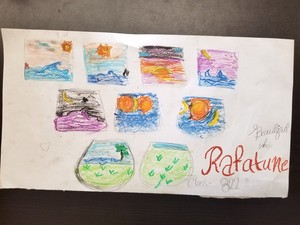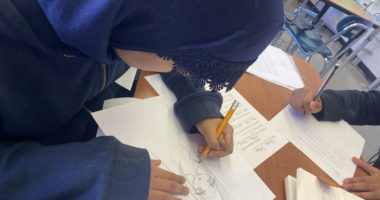Welcome Back!
For a Teaching Artist, it’s always easier going into your second year at a school. One understands the nuances of most of the students, builds a rapport with the classroom teacher, and most importantly, becomes familiar with how to get in and out of the building in a timely manner for your next gig. All Good things.
The one thing that doesn’t change, however, is building an exciting and engaging teaching path that meets the needs of your students. For this 2018-2019 school year at I.S. 126 Albert Shanker School for Visual & Performing Arts our students will be asked to think intentionally about their own creative process. What are our themes? Who inspires us? I want our students to begin to think about the sequential steps it takes to create a poem or a work of art, from an idea to a finalized product.
My teaching partner Shawn Ferreyra, CWP Teaching Artist & Illustrator, and I decided to collaborate with the students of Mr. Baron’s 6th and 8th grade Art Classes on a sequential art project that incorporates poetry into their own style under the technique of comic book traditions. For us, the thought was simple: the two genres were a perfect match. Throughout history, poetry and comic books are forms that use figurative language to illustrate and challenge inequalities that exist in the world. We decided to hold both these spaces as mediums for our students to create and be inspired.
We’ve also been challenged this year to have our students produce works that are unique to their own talents, but pushes them to thrive as more conscious consumers and producers of art. Our goal is to take that Community-Word Project Mantra, “I Have a Voice, My Voice is Powerful, My Voice Can Change the World!”; a mentra that lives in every one of our Teaching Artists’ minds as we go into the classroom.
How do I make this relevant to our students’ lives and experiences,
while simultaneously connecting back to the world at large.
We knew we wanted our students to think about three things when it comes to their own art: inspiration, (in)equality, and a sequential process. We scaffolded our first lesson plan so that it allowed us to introduce ourselves and our inspirations, themes, and art forms. Shawn spoke about Frank Miller, Stan Lee, and John Lewis who inspired him as an illustrator. And I brought up the likes of Sonia Sanchez, Nikki Giovanni, Tupac Shakur, and Kendrick Lamar as people that continually inspire my creative process. We then challenged the students in groups, to think of an A-Z List of Artists under the four different categories below:
-
Musician/Bands/Singers/Rappers
-
Authors/Writers/Poets
-
Visual Artists/Illustrators
-
Icons/Global Leaders

We finished by asking students draft their own creative license by thinking about art form, manual skills, crafts, and themes? They were instructed to fold a blank paper in fours. In each box they wrote a different categories: Art Forms, Inspirations, Themes, Words to Describe Yourself, and then respond by filling in the boxes appropriately.
This process allowed us to establish two individual student projects, A 3 Story Haiku Panel Comic and an Artist Ode, and a community project, Collaborative Sonnet, for our arts residency. In establishing a creative license, students can think intentionally about who they are as artists, while also using it later to lock-in on an art form or style to express their original haikus in a sequential piece. In creating the official A-Z List of Artists, it can act as a guide for students to choose someone from the list to research and then create an Artist Ode (visual or written) inspired by that artist.
Our early sessions set the artistic tone while simultaneously establishing the residency goals of our teaching path. These lessons also allowed us to know more about our students, the artist they know, and familiar art forms. It also helps keep the teaching path fluid and honest. We want it to be a rigorous and fun opportunity for students to express themselves, learn more about themselves, and simply exist in a space where their voice is often neglected.
How do we do that? We keep the personality in the room; the personality of the teaching artist involved, but most importantly the personality of the students we serve. Personality is key to the creation of this poetry and comic mash-up.



